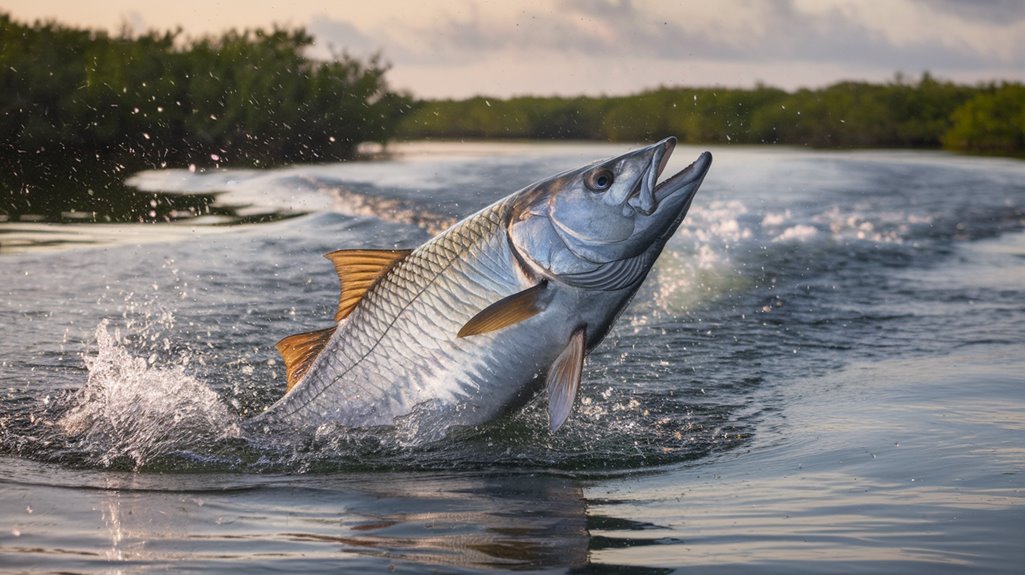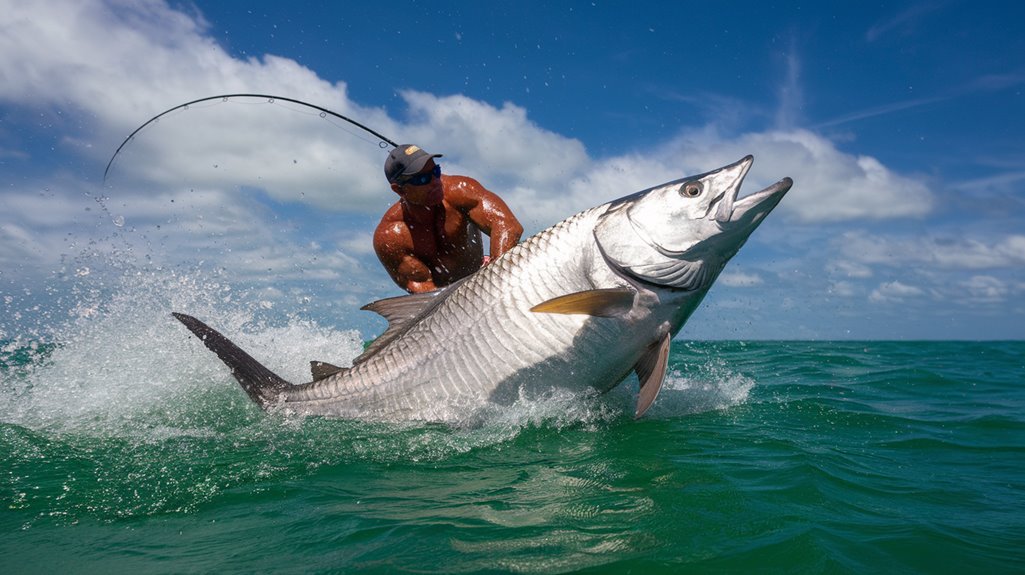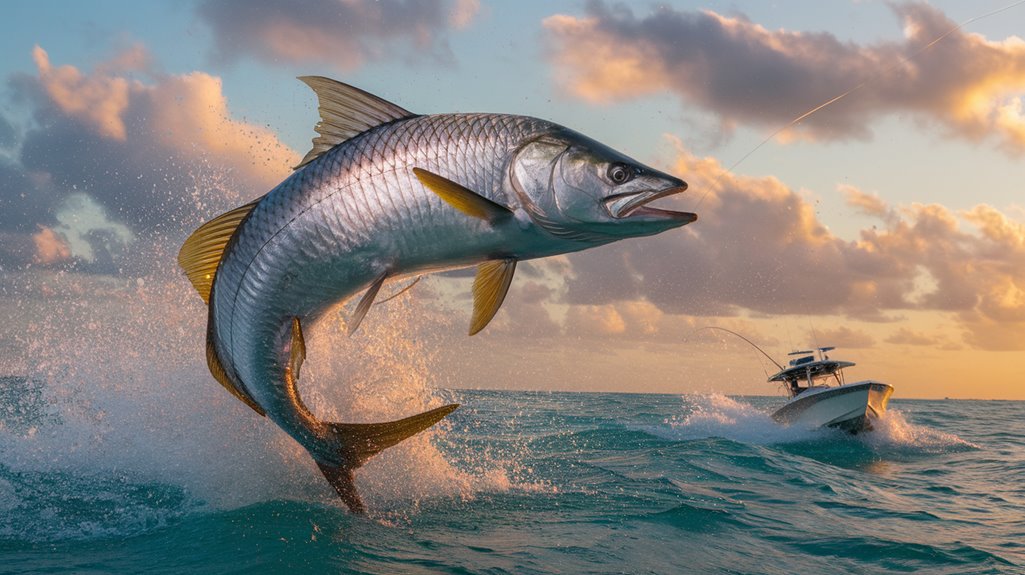You'll discover that tarpon fishing demands more than just casting a line and hoping for the best. These ancient predators, weighing up to 200 pounds, require specific gear, precise timing, and advanced techniques to target successfully. Whether you're stalking them in Florida's crystal flats or the murky backcountry, each encounter presents unique challenges and potential dangers. The pursuit of these magnificent "silver kings" tests both your angling skills and your nerve.
- Key Takeaways
- The Magnificent Silver Kings: Understanding Tarpon Biology
- Essential Gear and Tackle Selection
- Reading the Waters: Prime Tarpon Habitats
- Advanced Casting Techniques for Success
- Battle Strategies: Fighting and Landing Methods
- Seasonal Patterns and Migration Routes
- Conservation and Ethical Angling Practices
- Weather Patterns and Their Impact
- Local Knowledge and Guide Insights
- Common Mistakes and Learning Curves
- Frequently Asked Questions
- Conclusion
Key Takeaways
- Tarpon's massive size up to 280 pounds and powerful runs make them formidable opponents, requiring strength and stamina from anglers.
- Challenging weather conditions and migrations across vast distances demand strategic timing and location selection for successful catches.
- Advanced casting techniques and specialized gear are essential, as tarpon require precise presentation and robust equipment to handle their power.
- Fighting large tarpon involves physical risks from sudden jumps, powerful tail slaps, and potential equipment failures during extended battles.
- Conservation practices like barbless hooks and careful handling are crucial, balancing the thrill of pursuit with responsible fishing ethics.
The Magnificent Silver Kings: Understanding Tarpon Biology
Giants of coastal waters, tarpon command respect from anglers worldwide with their impressive size and aerial acrobatics. These remarkable game fish can stretch to 8 feet and tip the scales at over 280 pounds, showcasing nature's engineering at its finest.
You'll find these masters of the natural world equally at home in coastal waters, estuaries, and even freshwater environments, thanks to their specialized swim bladder. This unique adaptation allows them to gulp atmospheric oxygen, helping them survive in oxygen-poor conditions where other fish can't.
As juveniles, they'll stick to the protection of mangrove-lined shallows, feeding on smaller prey. Once mature, these silver kings migrate to deeper waters for spawning, demonstrating their incredible adaptability across different marine ecosystems.
Essential Gear and Tackle Selection
When choosing your tarpon rod, you'll need a 10-12 weight fly rod that can handle the powerful runs and acrobatic leaps of these massive gamefish. Your leader construction must incorporate 80-100 lb test fluorocarbon material to withstand the abrasive mouth and explosive strikes of tarpon. To maximize your chances of success, make certain your high-capacity reel holds at least 200 yards of backing and features a robust drag system that won't fail during extended fights.
Choosing Your Perfect Rod
Selecting the right rod stands as a cornerstone of successful tarpon fishing. When you chase tarpon in legendary spots like Boca Grande, you'll need a medium to heavy action rod rated between 8 to 12 weight. Your ideal rod length should fall between 8 to 9 feet, giving you ideal leverage for fly fishing and battling these powerful gamefish.
Choose a fast action rod to maximize your casting distance and line recovery – essential factors when targeting distant feeding tarpon. For material selection, graphite offers exceptional sensitivity and lightweight performance, while fiberglass provides superior durability and forgiving action for newer anglers. Don't forget to match your rod with a high-quality reel featuring a robust drag system, as tarpon's explosive runs and aerial displays will put your equipment to the ultimate test.
Mastering Leader Construction
Building a proper leader system ranks among the most important technical aspects of tarpon fishing. You'll need a 60-80 lb test fluorocarbon leader for its near-invisible properties and superior abrasion resistance. Add a shock tippet of 18-24 inches to absorb the intense stress from your tarpon's acrobatic displays.
Connect your leader to the fly line using either a loop-to-loop connection or a nail knot to guarantee smooth casting shifts. Don't forget to incorporate a bite tippet if you're fishing waters where sharp-toothed species might compromise your line. You must inspect your leader system regularly for any signs of wear, nicks, or abrasions. Even minor damage can lead to catastrophic failure when you're battling these powerful gamefish.
Reading the Waters: Prime Tarpon Habitats

Successful tarpon fishing begins with understanding where these majestic game fish prefer to spend their time. You'll find them frequenting warm coastal waters between 75°F and 85°F, particularly in estuaries and near mangrove-lined shores where baitfish congregate.
Focus your search on depths of 10 to 30 feet, especially in areas where tidal movements create natural ambush points. During warmer months, you'll need to track their migration patterns between inshore and offshore waters. The Florida Keys, Gulf of Mexico, and Caribbean offer prime fishing grounds where you can intercept these seasonal movements.
Monitor tide tables, moon phases, and weather patterns carefully, as these factors directly influence tarpon feeding behavior. You'll increase your success rate by targeting areas where multiple favorable conditions align, particularly during peak migration periods.
Advanced Casting Techniques for Success
Mastering advanced casting techniques separates novice tarpon anglers from those who consistently land these magnificent fish. The double haul technique is essential for generating the line speed you'll need to reach tarpon in deeper waters. You'll want to focus on perfecting your timing and rhythm while maintaining precise control over your load and release.
When casting into the wind, adjust your angle and increase your power to guarantee accurate fly placement. Practice with weighted lines to develop the muscle memory needed for efficient shooting techniques. Don't forget to employ the strip set rather than a traditional hook set when you get a strike. Your success rate will improve dramatically by using specialized tarpon flies combined with these advanced casting methods, particularly during active feeding periods.
Battle Strategies: Fighting and Landing Methods

Landing a hooked tarpon demands a precise combination of technique and equipment control. You'll need a strong, flexible rod to absorb the fish's powerful runs and aerial displays. Set your drag to 20-25% of your line's breaking strength to maintain control while allowing necessary runs.
Keep steady pressure on the fish, but don't overpower it, as excessive force often results in lost hooks. When your tarpon goes airborne, you'll need to anticipate these jumps and adjust your rod angle quickly to prevent the hook from shaking loose. As you bring the fish alongside the boat, use a net or cradle for safe handling. This approach protects both you and the tarpon during the final stages of the fight, especially vital for catch-and-release situations.
Seasonal Patterns and Migration Routes
You'll find tarpon following predictable migration patterns along the Atlantic coast, moving south during fall months and returning north in spring as they track ideal water temperatures and baitfish populations. To locate these powerful gamefish, focus on the Florida Keys, Gulf of Mexico, and Caribbean waters where schools of hundreds gather around strong currents and abundant prey. During the peak spawning months of June and July, you can maximize your chances by targeting warm, shallow waters where these massive fish congregate in significant numbers.
Yearly Movement And Routes
To maximize your chances of encountering tarpon, you'll need to understand their predictable yearly migration patterns. These magnificent fish travel extensive routes along the Gulf Coast of Florida, following water temperature changes and baitfish movements throughout the seasons.
- Moving from deep offshore waters to shallow coastal areas during April-September
- Migrating northward through the Florida Keys during warmer months
- Traveling south as water temperatures drop in fall and winter
- Covering distances up to 1,000 miles between breeding and feeding grounds
- Following abundant baitfish populations in warmer waters
Tracking these migration routes is essential for successful tarpon fishing. You'll find them most accessible in coastal waters during the warmer months when they move inshore to feed and breed. This predictable pattern allows you to position yourself strategically along their migration path for ideal fishing opportunities.
Tracking Tarpon School Patterns
Building on these migration patterns, successful tarpon anglers learn to identify and track specific school behaviors throughout the seasons. You'll find juvenile tarpon in protected shallow waters, while adults prefer deeper channels during their spring-to-fall movements. Watch for their characteristic acrobatic displays, which often signal the presence of large schools.
| Season | Location | Behavior |
|---|---|---|
| Spring | Coastal passes | Spawning aggregations |
| Summer | Deep channels | Active feeding/jumping |
| Fall | Offshore waters | Pre-migration schooling |
To maximize your success, you'll need to monitor water temperature and tidal movements, as these factors directly influence tarpon migration routes. Focus your efforts during the peak months of April through September, when you'll find the largest concentrations of fish moving along predictable coastal pathways.
Conservation and Ethical Angling Practices
While tarpon populations face increasing pressure from habitat loss and overfishing, responsible anglers play an essential role in their conservation through ethical fishing practices. You'll need to adopt sustainable techniques and follow IGFA guidelines to protect these magnificent fish for future generations.
- Use barbless hooks to minimize injury and facilitate quick releases
- Handle fish carefully to reduce stress, keeping them in the water whenever possible
- Follow local size limits and catch restrictions to protect juvenile populations
- Time your fishing around spawning cycles to avoid disrupting reproduction
- Support habitat conservation efforts, particularly in mangrove and wetland areas
Understanding tarpon behavior and implementing proper catch-and-release methods isn't just good practice—it's essential for the species' survival. You're part of a larger conservation effort when you choose to fish responsibly and support ecosystem preservation initiatives.
Weather Patterns and Their Impact
Beyond practicing ethical angling, understanding weather patterns becomes a powerful tool in your tarpon fishing arsenal. You'll need to monitor El Niño conditions, which can drastically affect water levels and migration patterns. When you're tracking barometric pressure, remember that lower readings often trigger increased feeding activity – a vital detail for planning your trips.
| Weather Condition | Impact on Tarpon |
|---|---|
| Low Pressure | Enhanced Feeding |
| High Pressure | Reduced Activity |
| Strong Winds | Poor Visibility |
| Sudden Storms | Altered Behavior |
You'll want to pay close attention to wind direction and speed, as these factors directly influence water surface conditions and your presentation effectiveness. During seasonal changes, temperature shifts can greatly impact migration timing, requiring you to adjust your fishing schedule accordingly.
Local Knowledge and Guide Insights
You'll discover that local guides carry decades of accumulated wisdom about tarpon behavior, seasonal patterns, and the intricate waterways they navigate. These river experts have developed time-tested techniques for ideal fly selection, casting strategies, and reading water conditions specific to their regions. By tapping into their extensive knowledge base, you'll gain access to closely guarded fishing locations and methods that have proven successful through years of practical experience.
Decades Of Fishing Wisdom
When it comes to mastering tarpon fishing, there's no substitute for the decades of accumulated wisdom passed down through local guides and fishing communities. You'll find that success depends heavily on understanding the intricate patterns of tides, moon phases, and seasonal fish behavior that experienced guides have observed over years of practice.
- Learn to read local waterways like seasoned guides who know every channel and flat
- Time your fishing trips according to proven tide and lunar phase patterns
- Study the behavior of local baitfish species to predict tarpon movements
- Select appropriate tackle based on regional expertise and specific conditions
- Connect with local fishing communities to gather time-tested techniques
This collective knowledge forms the foundation of effective tarpon fishing, combining traditional wisdom with modern technical understanding to maximize your chances of success.
Secrets From River Experts
Local river experts and seasoned guides hold the keys to revealing tarpon fishing's most closely guarded secrets. You'll benefit from their intimate knowledge of seasonal migration patterns and feeding habits that can dramatically improve your success rate. These experts understand precisely where tarpon congregate in complex waterways during specific times and conditions.
You'll need to master the art of stealth, as guides emphasize that even subtle disturbances can spook these sensitive fish. Pay close attention to their recommendations about local weather patterns, particularly El Niño effects, which influence tarpon movements. When selecting bait or flies, trust their ecosystem-specific suggestions – they've refined these choices through years of observation. By tapping into this localized expertise, you're not just fishing; you're applying proven techniques that match the exact behaviors of tarpon in their natural habitat.
Common Mistakes and Learning Curves
Successfully targeting tarpon requires mastering several critical skills and avoiding common pitfalls that can derail even experienced anglers. You'll need to understand the nuances of fly selection, casting mechanics, and hook-setting techniques to improve your success rate on the water.
- Choose flies that match local forage and seasonal patterns to increase your strike ratio
- Practice accurate casting techniques, focusing on placement over distance
- Set hooks quickly and firmly when you feel a strike to prevent the fish from throwing the hook
- Fine-tune your reel's drag settings based on conditions and fish size
- Study water conditions and tarpon behavior patterns in your fishing area
Understanding these fundamentals will help you avoid the frustrating learning curve that many anglers face when pursuing these magnificent gamefish. Pay attention to details, adapt to changing conditions, and maintain proper equipment settings.
Frequently Asked Questions
Why Is Tarpon Fishing Illegal?
You'll find tarpon fishing isn't universally illegal, but it's restricted in specific regions to protect breeding cycles, prevent overfishing, and allow population recovery in vulnerable areas facing habitat destruction.
What Month Is Best for Tarpon Fishing?
You'll find peak tarpon fishing from May to June, when water temperatures rise and spawning activities intensify. Time your trips around new and full moons for ideal conditions in coastal waters.
Where Is the Best Tarpon Fishing in the World?
You'll find the world's best tarpon fishing in Florida's Boca Grande Pass, known as the "Tarpon Capital," followed by the Florida Keys, Costa Rica's Caribbean coast, Mexico's Yucatán, and Andros Island, Bahamas.
What Is the Best Rig for Tarpon Fishing?
You'll need a 9-12 weight fly rod with large arbor reel, 20-50lb fluorocarbon leader, and 4/0-8/0 hooks. Use double loop knots and floating/intermediate line for best results.
Conclusion
As you've journeyed through the world of tarpon fishing, you've learned that success demands respect for both the fish and their environment. From selecting the right gear to mastering advanced techniques, you're now equipped to face these silver warriors. Remember: each cast, each battle, each release builds your expertise. Let the tides guide you, the winds inform you, and the tarpon challenge you on your path to angling mastery.

